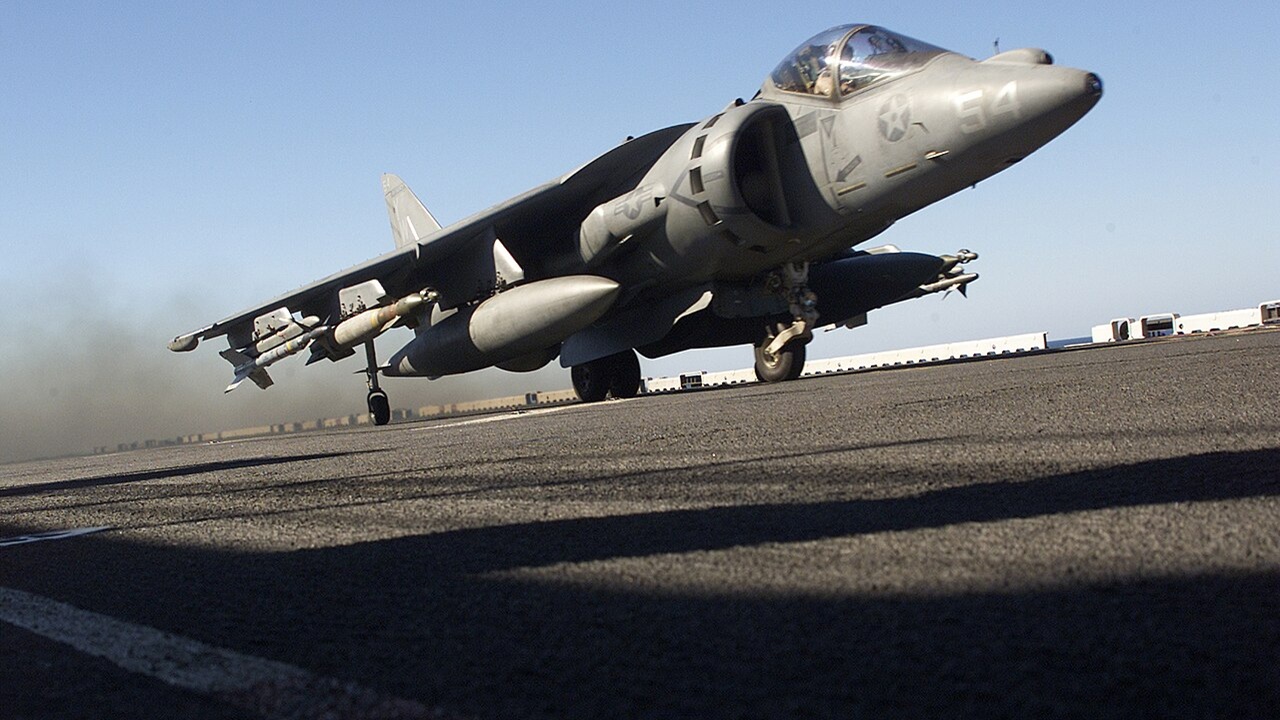
This Is the Fighter Jet the Marines Can’t Live Without
The design of the Harrier jump jet has allowed the Marine Corps to project air power in ways that would not have been possible with conventional aircraft.
The McDonnell Douglas AV-8B Harrier II is a unique and versatile aircraft that has served admirably with the Marine Corps for a generation. With its upcoming retirement, the Harrier is set to be replaced on a mission set that includes close air support (CAS), interdiction, and armed reconnaissance missions.
One of the primary reasons the Harrier has been able to undertake such a diverse set of missions is the jet’s ability to perform vertical or short takeoff and landing (V/STOL), which lends itself to operational flexibility. Unlike conventional aircraft that need a proper runway to take off and land, the Harrier can operate from short, unimproved airstrips, forward operating bases, and even small naval vessels. The ability to operate from just about anywhere enables the Harrier to support ground forces more directly and responsively, especially in austere environments where traditional airfields might be unavailable.
The AV-8B Harrier II’s Specifications
- Year Introduced: 1985 (AV-8B Harrier II, U.S. Marine Corps)
- Number Built: ~340 (including all variants of AV-8B)
- Length: 46 ft 4.5 in (14.13 m)
- Height: 11 ft 8 in (3.55 m)
- Wingspan: 30 ft 4 in (9.25 m)
- Weight: ~22,000 lb (10,000 kg) standard loadout
- Engine: 1 × Rolls-Royce Pegasus 11-61 vectored-thrust turbofan (23,500 lbf / 105 kN thrust)
- Top Speed: ~Mach 0.9 (approx. 673 mph or 1,083 km/h) at sea level
- Combat Radius: ~300–400 mi (480–640 km), mission-dependent
- Service Ceiling: ~43,000 ft (13,100 m)
- Loadout: Up to 9,200 lb (4,200 kg) of ordnance on six wing and one centerline hardpoints (total 7)
- Aircrew: 1
How the Marine Corps Uses the Harrier Jet
For the Harrier, a mission profile often involves launching from forward positions, reaching combat zones quickly, delivering precision ordnance, returning to re-arm and re-fuel, and repeating. That is why the Harrier has been an asset for the Marine Corps, where the jet’s agility and hardiness allow for timely support of ground troops.
The Harrier’s design closely supports the jet’s mission profile with several distinct features. Most notably, the Rolls-Royce Pegasus turbofan engine, which the Harrier is equipped with, has four swiveling nozzles that can direct thrust toward vertical flight or rearward for conventional flight. The Pegasus engine is what enables the Harrier to transition between hover, short takeoff, and high-speed forward flight.
The Harrier also features a structure built from lightweight composite materials and an enlarged wing area, which improves lift and payload capacity. The result is that the Harrier can carry a wider array of ordnance, including precision-guided munitions, missiles, rockets, and a GAU-12/U /U cannon, which increases the aircraft’s lethality when engaging in CAS or interdiction missions.
Avionics and sensor upgrades also enhance the Harrier’s combat effectiveness. Equipped with a digital cockpit, night vision compatibility, and systems such as the LITENING targeting pod, the Harrier has advanced electro-optical and infrared targeting capabilities, allowing for accurate target identification and engagement even at night. The Harrier’s cockpit layout is also engineered to allow the pilot to observe the battlefield from outside the cockpit. Features such as Hands-On Throttle and Stick (HOTAS) and Heads-Up Display allow the pilot to manage weapons and navigation systems while maintaining situational awareness.
The design of the Harrier has allowed the Marine Corps to project air power in ways that would not have been possible with conventional aircraft. The Harrier is flexible, quick-acting, and closely integrated with ground forces. The aircraft’s design emphasizes mobility, rapid deployment, and sustained support. While the Harrier is gradually being replaced with the Lockheed Martin F-35B Lightning II, the aircraft will always be America’s first jump jet, an icon of unconventional flight modes and no-frills ruggedness.
About the Author: Harrison Kass
Harrison Kass is a Senior Defense and National Security Writer at The National Interest. Kass is an attorney and former political candidate who joined the US Air Force as a pilot trainee before being medically discharged. He focuses on military strategy, aerospace, and global security affairs. He holds a JD from the University of Oregon and a master’s in Global Journalism and International Relations from NYU.
Image: Wikimedia Commons.
The post This Is the Fighter Jet the Marines Can’t Live Without appeared first on The National Interest.
















